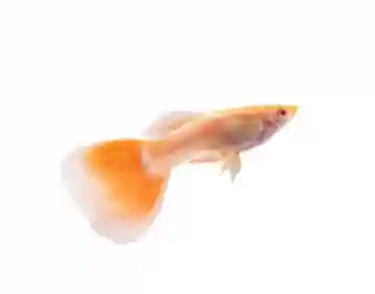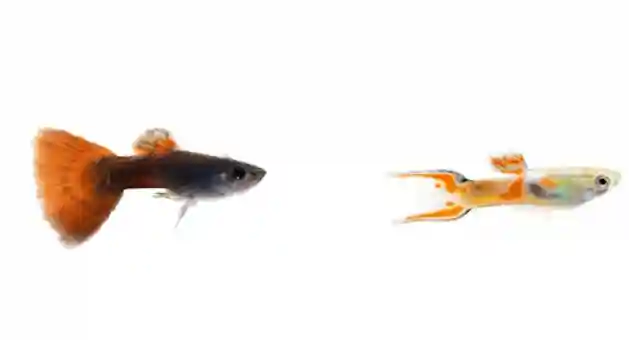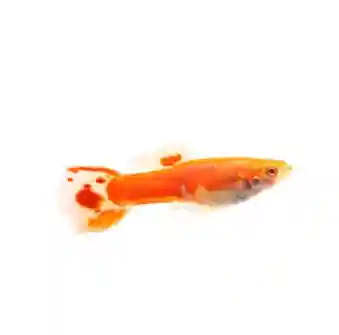Are you a fan of aquatic beauty? Looking to add a touch of brilliance to your aquarium? Look no further than fancy guppies! These charming fish are known for their stunning colors, graceful fins, and lively personalities. In this article, we’ll dive into the world of fancy guppies, exploring their characteristics, care requirements, and how to create an optimal environment for them to thrive. By the end of this article, you’ll be well-equipped to keep these fascinating fish and enjoy the beauty they bring to your aquatic haven.
Fancy Guppies: A Closer Look
Fancy guppies (Poecilia reticulata) are small, colorful freshwater fish native to the warm waters of South America, particularly in regions like Venezuela, Trinidad, and Barbados. Their striking appearance has made them a favorite among aquarium enthusiasts, earning them the nickname “the jewel of the aquarium.”
Their natural habitat is teeming with diversity, which is wonderfully reflected in the various guppy types cultivated over the years.
Types of Guppies and Varieties

- Delta Tail Guppies: These guppies boast a sleek and elegant delta-shaped tail. The tail’s broad edges and smooth curves create a stunning visual impact.
- Veil Tail Guppies: With elongated and flowing tails, veil tail guppies exude grace and beauty. Their tails can be single, double, or even tri-colored, adding to their allure.
- Swordtail Guppies: Named for their distinctive sword-like extension on the tail fin, they are a popular favorite. The swordtail can be of varying lengths and colors, making each one a unique masterpiece.
- Lyretail Guppies: Lyretail guppies have a tail fin resembling the graceful arc of a lyre. This unique tail shape is truly captivating and sets them apart in any aquarium.
- Fan Tail Guppies: True to their name, fan tail guppies have tails that open up like a fan, creating a symmetrical and eye-catching display.
- Round Tail Guppies: With a tail fin that forms a beautiful round shape, these guppies exhibit a classic charm that never goes out of style.

Advanced Care for Different Guppy Types
Each guppy type may have specific care requirements based on its tail shapes, colors, and genetic traits. Pay attention to the following:
- Water Parameters: Some guppy types might be more sensitive to water conditions. Research the specific needs of your chosen guppy variety to ensure optimal health.
- Breeding Considerations: If you’re interested in breeding, understanding the genetics of different guppy types is essential. Breeding for specific traits can be a rewarding endeavor.
- Tank Mates: While guppies are generally peaceful, it’s important to consider the compatibility of different guppy types with other fish species in your tank.
Elevating Your Aquarium with Guppy Diversity
By exploring the different guppy types and understanding their unique characteristics, you can elevate your aquarium from ordinary to extraordinary. Fancy guppies, with their exquisite colors and diverse forms, bring an enchanting beauty to your aquatic world. Whether you’re an experienced hobbyist or just starting your guppy journey, the splendor of guppy diversity awaits you.
The Beauty of Fancy Guppies

One of the most captivating features of fancy guppies is their incredible array of colors. Their bodies can showcase various hues, including vibrant blues, fiery reds, dazzling yellows, and even mesmerizing metallic shades. The combinations seem almost endless, making each guppy a unique masterpiece. These radiant colors aren’t limited to the body alone; guppies often boast intricate patterns and designs on their fins, adding to their allure.
Setting Up the Perfect Aquarium for Fancy Guppies
Creating a suitable environment for your fancy guppies is essential for their well-being. Here’s what you need to consider when setting up the perfect guppy paradise:
- Tank Size: Fancy guppies are relatively small fish, but they love to swim and explore. A tank size of at least 10 gallons is recommended for a small community of guppies.
- Water Temperature and Quality: Guppies thrive in water temperatures between 74°F and 82°F (23°C to 28°C). Maintain excellent water quality by using a filtration system and performing regular water changes.
- Decor and Plants: Provide plenty of hiding spots and create a natural-looking habitat with live or silk plants. Guppies appreciate places to rest and explore.
- Lighting: Opt for gentle lighting to mimic their natural environment. Avoid intense, direct light, as it can stress them.
Fancy Guppy Feeding Basics
Fancy guppies are omnivores, which means they enjoy a varied diet. A high-quality flake food formulated for tropical fish serves as a good base. Additionally, you can offer them live or frozen treats, such as brine shrimp, daphnia, or bloodworms. This diversity ensures they receive essential nutrients for optimal health and vibrant colors.

Feeding your fancy guppies goes beyond just tossing fish flakes into the tank. It’s about understanding their nutritional needs and providing them with a diverse diet that caters to their unique requirements.
Essential Nutrients for Guppies:
- Proteins: High-quality proteins are a must for guppies. They support growth, tissue repair, and overall health. Look for fish flakes that list quality fish meals as a primary ingredient.
- Carbohydrates: Carbs provide energy for your guppies. Choose flakes that include grains or vegetable matter as part of the ingredients.
- Vitamins and Minerals: A well-balanced diet should contain essential vitamins (like vitamin C) and minerals (like calcium) to support the immune system, enhance colors, and ensure proper bone development.
Feeding Frequency:
- Small, Frequent Meals: Fancy guppies have small stomachs, so it’s better to feed them small amounts several times a day rather than one large meal. This prevents overeating and maintains water quality.
- Daily Feedings: Aim for feeding your guppies once in the morning and once in the evening. A consistent feeding schedule helps them thrive.
Special Treats for Guppies:
- Live Foods: Fancy guppies relish live treats like brine shrimp, daphnia, and bloodworms. These protein-rich snacks simulate their natural diet and can enhance their colors.
- Frozen Foods: Frozen versions of the above live treats are readily available and provide similar benefits.
- Vegetables: Occasionally, offer blanched vegetables like spinach, zucchini, or peas. Guppies enjoy nibbling on them, and the fiber is good for their digestion.
Enhancing Colors and Vitality
A balanced diet not only supports overall health but also enhances the stunning colors that fancy guppies are known for. Here’s how you can maximize their beauty through nutrition:
- Carotenoid-Rich Foods: Foods containing carotenoids, like spirulina flakes or pellets, can intensify the reds, oranges, and yellows in their colors.
- Variety Is Key: Rotate their diet with a mix of high-quality flakes, live foods, and the occasional vegetable treat. Variety ensures they receive a wide range of nutrients.
- Don’t Overfeed: Overfeeding leads to water pollution and obesity in guppies. Feed them only what they can consume in a few minutes.
Elevating Your Guppy Care with Proper Nutrition
Feeding fancy guppies isn’t just a routine; it’s a vital aspect of ensuring their well-being and showcasing their full beauty. By following the nutritional guidelines outlined here, you’ll be providing your guppies with the best possible care, allowing them to thrive, display their radiant colors, and become the stars of your aquarium.
Breeding Beauty: Guppy Reproduction
Fancy guppies are prolific breeders, making them an ideal choice for aquarists interested in witnessing the miracle of life in their aquarium. The females give birth to live fry, and the pregnant guppy’s gravid spot, a dark spot near the anal fin, becomes more prominent as she nears delivery. To ensure fry survival, it’s essential to provide hiding spots for them within the tank, as adult guppies may consider them as potential snacks.
Understanding Guppy Reproduction
Guppies are prolific breeders, making them a popular choice for aquarists interested in observing the magic of new life. Let’s explore the intricacies of guppy reproduction and how you can create a breeding-friendly environment.
Identifying Pregnant Guppies:
- Gravid Spot: As female guppies become pregnant, a dark spot called the gravid spot appears near their anal fin. This spot gradually becomes more prominent as pregnancy progresses.
- Swollen Abdomen: Pregnant female guppies develop a noticeably swollen abdomen as they carry developing fry. The belly becomes rounder and more pronounced.

Creating the Ideal Breeding Environment:
- Separate Breeding Tank: Consider setting up a separate breeding tank to protect pregnant females and the fry from potential predators.
- Plenty of Hiding Spots: Provide ample hiding spots within the breeding tank using live or artificial plants. This gives pregnant guppies and newborn fry a safe refuge.
- Controlled Water Conditions: Maintain stable and clean water parameters in the breeding tank. Sudden water parameter fluctuations can stress guppies and impact breeding.
Ensuring Fry Survival:
- Seclude the Female: When you notice a female guppy’s gravid spot becoming prominent, consider moving her to the breeding tank. This allows you to monitor her more closely and protect the fry once they’re born.
- Remove Adult Guppies: Once the fry is born, adult guppies may see them as a potential snack. Remove the adults and leave the fry to grow in a safe environment.
- Feeding Fry: Provide specialized fry food (powdered fish food or liquid fry food) to ensure the tiny fry receives proper nutrition. Feed them small amounts multiple times a day.#
Breeding Guppies Success: A Rewarding Journey
Breeding guppies offer a remarkable opportunity to witness the wonders of life in your aquarium. By understanding the signs of pregnancy, providing a suitable breeding environment, and ensuring the survival of the fry, you’ll embark on a rewarding journey, nurturing new life and contributing to the ever-evolving beauty of the guppy world.
Conclusion
Fancy guppies are true gems of the aquarium world, enchanting us with their dazzling colors and lively personalities. By understanding their needs, providing a suitable environment, and caring for them with dedication, you can create a captivating underwater display that will bring joy and beauty to your life.
Frequently Asked Questions (FAQs)
-
How many guppies can I keep in a 10-gallon tank?
10-gallon tank can comfortably accommodate around 5 to 7 fancy guppies. Ensure not to overcrowd the tank, as it can lead to stress and water quality issues.
-
Can I keep male and female guppies together?
Yes, but keep in mind that guppies are prolific breeders. If you don’t want to breed them, consider having only males or females to avoid a population explosion.
-
How often should I feed my guppies?
Feed your guppies small amounts multiple times a day. This helps prevent overfeeding and keeps the water quality stable.
-
Are fancy guppies suitable for beginners?
Yes, fancy guppies are often recommended for beginners due to their hardiness and ease of care. However, it’s essential to research proper care guidelines before bringing them home.
-
What’s the lifespan of fancy guppies?
Fancy guppies typically live for around 2 to 3 years, but with excellent care, they can sometimes exceed this lifespan.
-
Can I keep fancy guppies with other fish?
Yes, but choose compatible fish that have similar water temperatures and dispositions. Avoid aggressive or fin-nipping species.
-
Can I keep different guppy types together in one tank?
Yes, but be aware of the specific needs of each guppy type and ensure that they are compatible in terms of water conditions and temperament.
-
Do different guppy types interbreed?
Guppies are known for their prolific breeding, and different types can interbreed. If you want to maintain purebred strains, consider keeping them separate.
-
Are there specific care tips for maintaining the colors of different guppy types?
While the general care principles apply, some guppy types, especially those with vibrant colors, may benefit from a diet rich in carotenoids to enhance their pigmentation.
-
How long does it take for guppy fry to grow?
Guppy fry grows quickly, and within a few weeks, they should be large enough to start accepting finely crushed regular flake food.
-
Can I breed different guppy varieties together?
Yes, you can, but keep in mind that breeding different varieties might lead to mixed traits in the fry. If you want to maintain purebred strains, keep them separate.
-
How many fry can a female guppy give birth to?
Female guppies can give birth to anywhere from 20 to 100 or more fry, depending on various factors such as the guppy’s age, size, and overall health.




